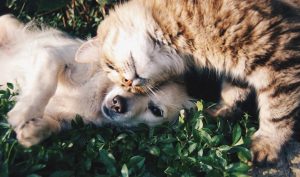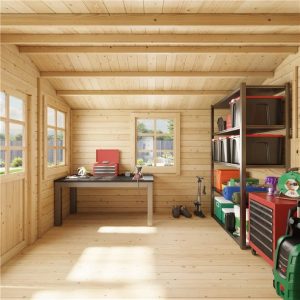A pet house where your four-legged friend can stretch their legs and lie down in comfort is great. Even better is one that gives them ample space to move around, play with friends, and allow you to join them! You can do just that with a garden shed, even with a small unit.
If you’re interested, here are some considerations, along with ideas, to help you get off to a great start.
Garden Shed Retreat for Cats and Dogs
You need to plan, design, and decorate the shed retreat to make it comfortable for your pets. There’s a lot to consider and work on, including:
The needs of your pets
Every pet is different, so your shed should match their size, habits, and preferences.
- Space: Make sure the shed is spacious enough for your pet to move around comfortably. Refer to our guide, ‘What Shed Size Should You Buy?’ for tips on choosing the right size for your outdoor area. Larger dogs or several animals together might need a greater amount of room.
- Sunlight: Pets love to sunbathe, so position the shed where it gets plenty of sunlight. This will help keep the inside warm and bright. But be careful about heatwaves – pets can die if they are locked in a hot container, so never shut them in on a hot day. You should also read our guide on How to Keep your Garden Shed Cool in the Summer.
- Power: A garden shed with electricity is optional, but your pets will thank you for extra comfort. With this, you can install lights, heating, and cooling systems.
- Insulation: Shed insulation will keep their retreat warm in the winter and cool in the summer. But never leave your pets unattended during extreme weather, like heatwaves in summer. Bring them back home when conditions are harsh.
- Access: Install large doors to allow your pet to come and go as they please. This way, they can enjoy their retreat and explore the garden. Consider an external caged area so they can have fresh air while still remaining secure.
- Furniture: Fur parents have their garden furniture, so it’s only fair that pets have their own, too. Cats, in particular, love having furniture to play on (and chew and rip apart). You may add a cat tree or shelves where they can jump and climb around.
Install new shed flooring
Now it’s time to give the floor an upgrade with either vinyl or sealed wood. We decided to go for these options as both are easy to clean, gentle on paws, and won’t hold onto mess or smells. You can DIY this too if you have a free weekend.
Vinyl can be cut to size and laid over the existing shed floorbards. If you opt for wooden boards, they can be fixed straight on top as well. Just keep in mind this will raise the floor slightly, which might affect door clearance. Finish the look with a few rugs or mats to give them a cosy patch to curl up, roll, or play chase.
We would suggest not fixing anything too securely if the wood of the building is prone to expansion and contraction as this can lead to cracks and gaps.
Low-pile rugs or carpets have short fibres, which means less snagging from claws. Synthetic types, like nylon, are also great as they resist stains and moisture. What you want to avoid are those fluffy, long-pile ones.
For year-round use, read this helpful guide next: How to Insulate a Shed Floor
Decide the shed retreat’s purpose or layout
Is it going to be a place for them to sleep? Or will it have it a grooming corner, a bath, or a spot for you to hang out with them? There are plenty of options, so might as well make it work for both you and your pets.
You could add a grooming station with storage the bathing essentials. With enough place to stash items, maximise them for your garden and outdoor stuff too. This saves you the hassle of clutter and going back and forth from the garage.
After deciding what the shed is for, plan the interior around it – and it’s up to you what to include.
Set up a multi-zone layout
You can pull this off even in a small space, especially for tiny pooches who think they own the place anyway. One area for sleeping, another for play, and maybe a spot for grooming or washing if you plan to include that. Add different textures or surfaces to mark zones, like a mat for a bed or a patch of lino for messy paws.
A few low shelves or a small table can hold toys, grooming bits, or treats. If possible, leave a little corner open for toys they can move around themselves. This gives them something to do and keeps the shed a bit more interesting.
Build a maintenance routine
A pet shed doesn’t have to be high-maintenance, but a bit of attention stops it turning into chaos. Sweep the floors, wash the bedding, and clear out the fur before it starts forming its own ecosystem.
And since this will be their new playhouse, make sure the shed is free from boards or nails coming loose or leaks. Watch for pests too; mice, insects, or the odd bird can sneak in.
Tip: We recommend marking a calendar for seasonal checks. For instance, ensure ventilation is working well in summer. Come autumn,clear out any fallen leaves, and so on.
Extra niceties for your pets
A squishy cushion or a heated pad will have them claiming a corner as their own in winter. A small water station nearby also keeps hydration easy and convenient.
Don’t forget a few pet-safe plants, like catnip, lavender, or basil, to give them something to sniff and explore. It’s a nice little addition that connects their retreat to the garden too, isn’t it? And if the sun is out, a patch of shade nearby turns the garden into their personal sun‑and-shade setup.
And, of course, toy for sensory fun! Cats love a good scratching post or a dangling toy they can bat around. Dogs enjoy chew toys or a little sandbox to dig in. Hiding treats around the shed adds a bit of excitement for both.
Pet-proof the space
One of the safety rules is to keep anything sharp and chemicals out of reach. A wobbly board, a loose wire, or a low shelf might catch a paw, so move it out of the way or cushion it. Alternatively, cover anything that needs to be covered with chew-resistant covers.
If your four-legged friends are sneakey, install mesh screens on windows or doors. While you’re at it, double-check the door and ensure it can’t accidentally lock your pets in.
There you have it! With these tips and tricks, you can create a comfortable shed retreat for your pets. Don’t forget to add a few personal touches, which we’ll leave up to you.
Looking for a shed for your pets? Tap the button below to find the right one:





